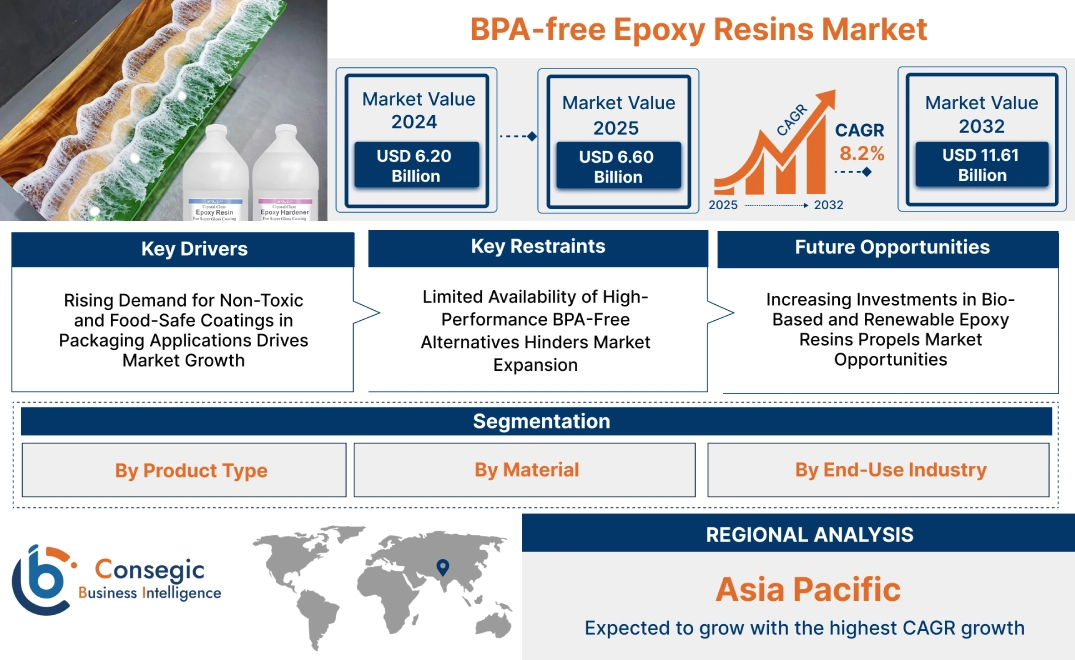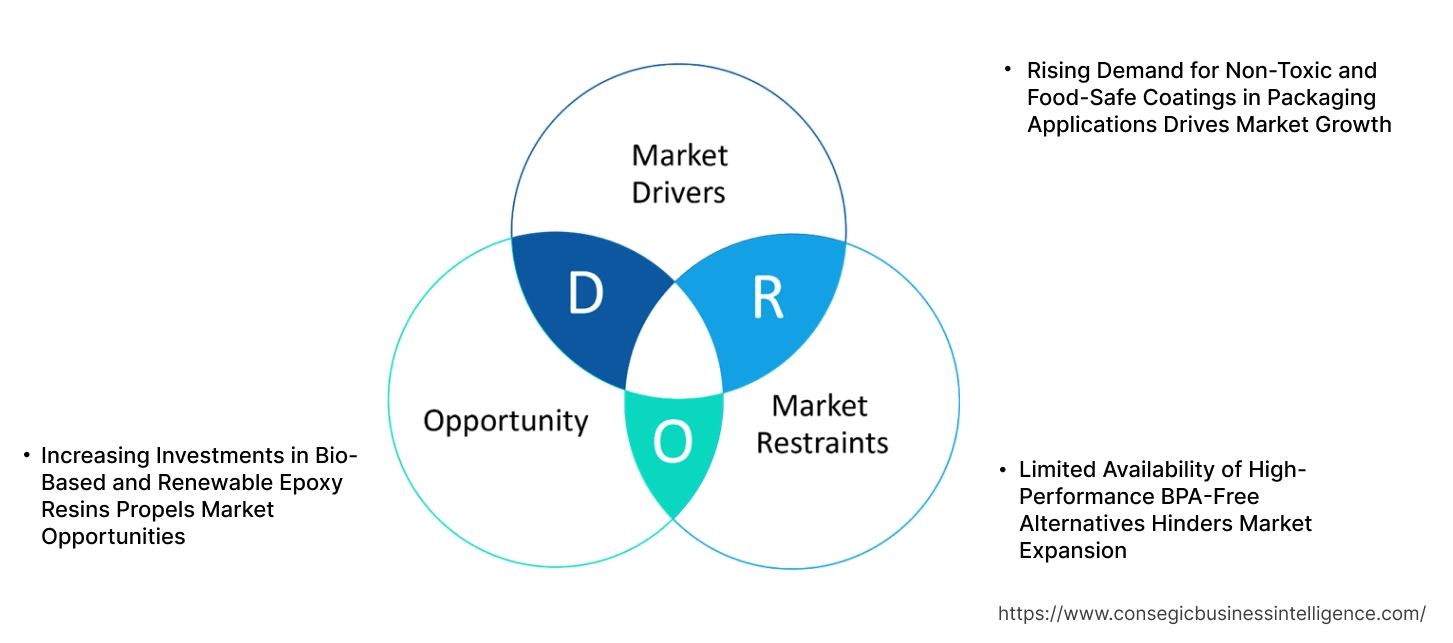- Summary
- Table Of Content
- Methodology
BPA-free Epoxy Resins Market Size:
BPA-free Epoxy Resins Market size is estimated to reach over USD 11.61 Billion by 2032 from a value of USD 6.20 Billion in 2024 and is projected to grow by USD 6.60 Billion in 2025, growing at a CAGR of 8.2% from 2025 to 2032.
BPA-free Epoxy Resins Market Scope & Overview:
BPA-free epoxy resins are advanced coating and adhesive materials formulated without the chemical bisphenol A, ensuring safer and more sustainable applications. These resins provide high durability, chemical resistance, and strong adhesion, making them suitable for industries such as packaging, electronics, and construction. Their enhanced formulation meets safety regulations while maintaining performance across various applications.
Key features include non-toxic composition, high thermal stability, and resistance to moisture and corrosion. These properties contribute to extended product lifespan, improved environmental safety, and reliable structural integrity. The resins are available in liquid, solid, and powder forms, catering to different industrial requirements and manufacturing processes.
Industries such as food packaging, automotive, and protective coatings incorporate these resins for enhanced product safety and durability. Advancements in resin technology continue to refine their mechanical properties, ensuring compatibility with evolving industry standards and expanding their functional applications.
Key Drivers:
Rising Demand for Non-Toxic and Food-Safe Coatings in Packaging Applications Drives Market Growth
Traditional BPA-based coatings in canned food linings, beverage containers, and food storage solutions have raised health concerns due to potential chemical leaching. As regulatory bodies such as the FDA, EU Commission and WHO impose stricter regulations on BPA usage in food contact materials, manufacturers are shifting toward BPA-free epoxy resins to ensure compliance and consumer safety.
- For instance, in December 2024, the EU banned the use of BPA in food contact materials due to its harmful health effects, specifically on the immune system.
Additionally, the rise in organic, sustainable, and health-conscious food brands has fueled demand for packaging solutions that eliminate harmful chemicals while maintaining product integrity. The push for eco-friendly packaging alternatives, including recyclable and biodegradable coatings, is further accelerating market adoption. With ongoing research and technological advancements in food-grade resins, the transition toward safer materials is expected to contribute significantly to BPA-free epoxy resins market expansion worldwide.
Key Restraints:
Limited Availability of High-Performance BPA-Free Alternatives Hinders Market Expansion
While BPA-free epoxy resins offer safer and more sustainable solutions, many formulations still struggle to match the mechanical strength, heat resistance, and chemical stability of traditional BPA-based resins. Industries such as aerospace, automotive, and electronics require high-durability coatings and adhesives, but current BPA-free options lack the same level of toughness and long-term reliability. Additionally, research into new resin formulations and curing agents requires extensive testing and regulatory approvals, slowing market expansion. Companies investing in advanced material development must focus on improving thermal stability, impact resistance, and chemical compatibility to compete with conventional solutions. Overcoming these technical challenges through continuous innovation and industry collaboration will be essential for ensuring BPA-free epoxy resins market growth across various applications.
Future Opportunities:
Increasing Investments in Bio-Based and Renewable Epoxy Resins Propels Market Opportunities
Manufacturers are developing plant-derived and lignin-based resins to reduce reliance on petrochemical feedstocks and lower the carbon footprint of epoxy resin production. This development is bolstered by the global push toward circular economy principles, where industries prioritize biodegradable and recyclable materials in packaging, coatings, and adhesives. Additionally, the growth of government initiatives promoting green chemistry and sustainable manufacturing practices is accelerating research into low-VOC, non-toxic resin formulations. As companies seek high-performance alternatives with minimal environmental impact, bio-based resins present an opportunity for expanding product portfolios in industries such as construction, automotive, and electronics.
- For instance, in November 2023, AGC Vinythai and Michigan State University’s Prof. Mojgan Nejad collaborated with allnex to replace BPA in epoxy resin with lignin.
The shift toward renewable epoxy formulations is expected to unlock new BPA-free epoxy resins market opportunities, supporting the transition to safer, more sustainable material solutions.
BPA-free Epoxy Resins Market Segmental Analysis :
By Product Type:
By product type, the market is categorized into waterborne, solvent-borne and powder.
The waterborne segment held the largest BPA-free epoxy resins market share in 2024.
- Waterborne resins are gaining traction due to their lower volatile organic compound (VOC) content, making them environmentally friendly and compliant with regulatory standards.
- The need for sustainable and non-toxic epoxy solutions is driving its adoption in construction, packaging, and automotive applications.
- As per market analysis, waterborne resins are preferred for coatings and adhesives as they offer durability without health concerns.
- For instance, allnex offers several cost-effective, organic, BPA-free waterborne resins for multiple applications.
- BPA-free epoxy resins market trends suggest that technological advancements in waterborne formulations are enhancing their adhesion, chemical resistance, and drying properties.
The powder segment is anticipated to experience the fastest CAGR during the forecast period.
- Powder-based resins are widely used in high-performance coatings for industrial, automotive, and electronic applications due to their excellent thermal stability and corrosion resistance.
- The need for solvent-free, long-lasting epoxy coatings is increasing, particularly in aerospace, transportation, and marine industries.
- Segmental trends indicate that powder coatings are gaining momentum, providing superior durability while meeting sustainability goals.
- With a shift towards solvent-free formulations, powder-based resins are contributing to BPA-free epoxy resins market growth.
By Material:
By material, the market is segmented into acrylic-based coatings, vinyl-based coatings, oleo, polyethylene, and others.
The acrylic-based coatings segment held the largest market share in 2024.
- Acrylic-based resins offer excellent adhesion, UV resistance, and weather durability, making them widely used in construction, packaging, and protective coatings.
- The need for advanced, non-toxic coatings in food packaging and industrial applications is driving growth in this segment.
- BPA-free epoxy resins market analysis suggests that acrylic formulations are replacing traditional BPA-based epoxy resins, ensuring regulatory compliance.
- As per segmental trends analysis, acrylic-based coatings are becoming the preferred choice due to their enhanced chemical resistance and fast-curing properties.
The polyethylene segment is expected to have the fastest CAGR during the forecast period.
- Polyethylene-based resins are widely used in flexible packaging, food storage, and protective coatings, providing durability and moisture resistance.
- The need for BPA-free alternatives in food and beverage packaging is increasing, aligning with consumer health concerns and regulatory mandates.
- Market trends indicate that polyethylene-based resins are being adopted for eco-friendly, recyclable packaging solutions.
- As sustainability efforts continue to rise, this segment is expected to drive BPA-free epoxy resins market expansion.
By End-Use Industry:
By end-use industry, the market is segmented into construction & infrastructure, automotive & transportation, aerospace & defense, food & beverage packaging, electrical & electronics, marine, and others.
The food & beverage packaging segment held the largest BPA-free epoxy resins market share of 30.5% in 2024.
- The transition toward BPA-free packaging solutions is driving strong demand for epoxy coatings in food and beverage containers, ensuring safety and compliance.
- The need for non-toxic, corrosion-resistant coatings is rising as brands focus on sustainable and consumer-friendly packaging options.
- BPA-free epoxy resins market analysis confirms that manufacturers are investing in innovative resin formulations to enhance food packaging safety.
- As per market trends, the shift towards bio-based coatings in packaging applications is further supporting market growth.
The electrical & electronics segment is expected to experience the fastest CAGR during the forecast period.
- These resins are increasingly being used in circuit boards, insulation coatings, and encapsulation materials, ensuring long-lasting electronic components.
- The need for high-performance, heat-resistant epoxy formulations is increasing in the semiconductor and consumer electronics industries.
- BPA-free epoxy resins market trends highlight the development of halogen-free and lead-free electronic coatings, enhancing product safety and regulatory compliance.
- With rising innovation in electronics manufacturing, this segment is driving market growth.
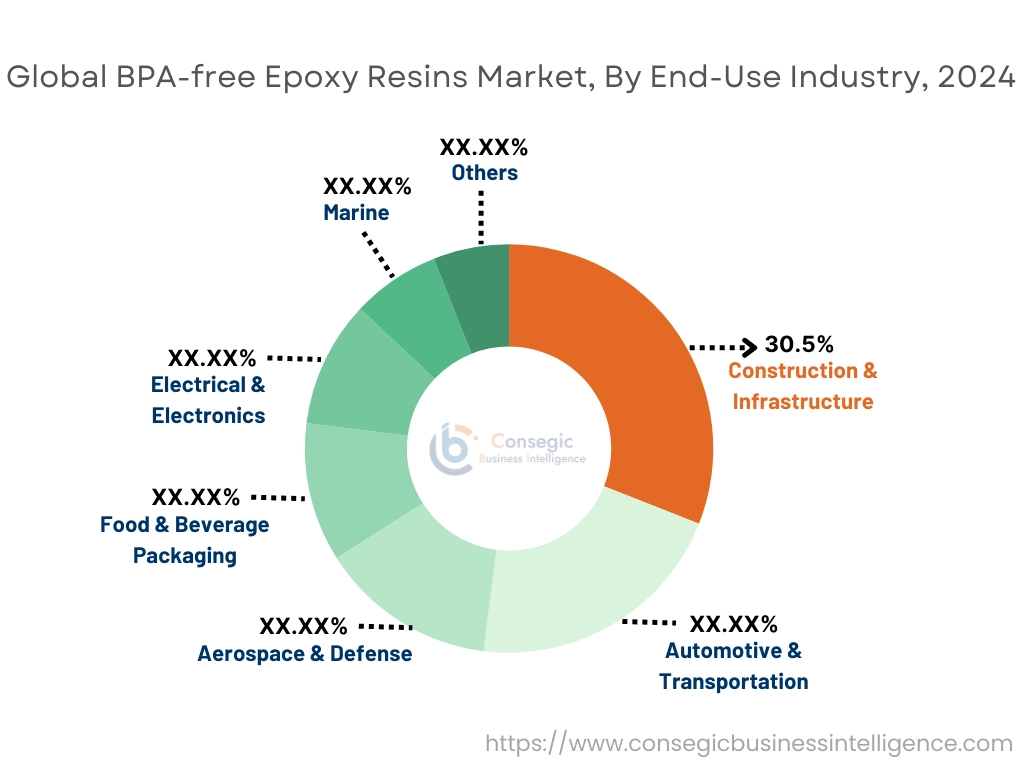
Regional Analysis:
The regions covered are North America, Europe, Asia Pacific, the Middle East and Africa, and Latin America.
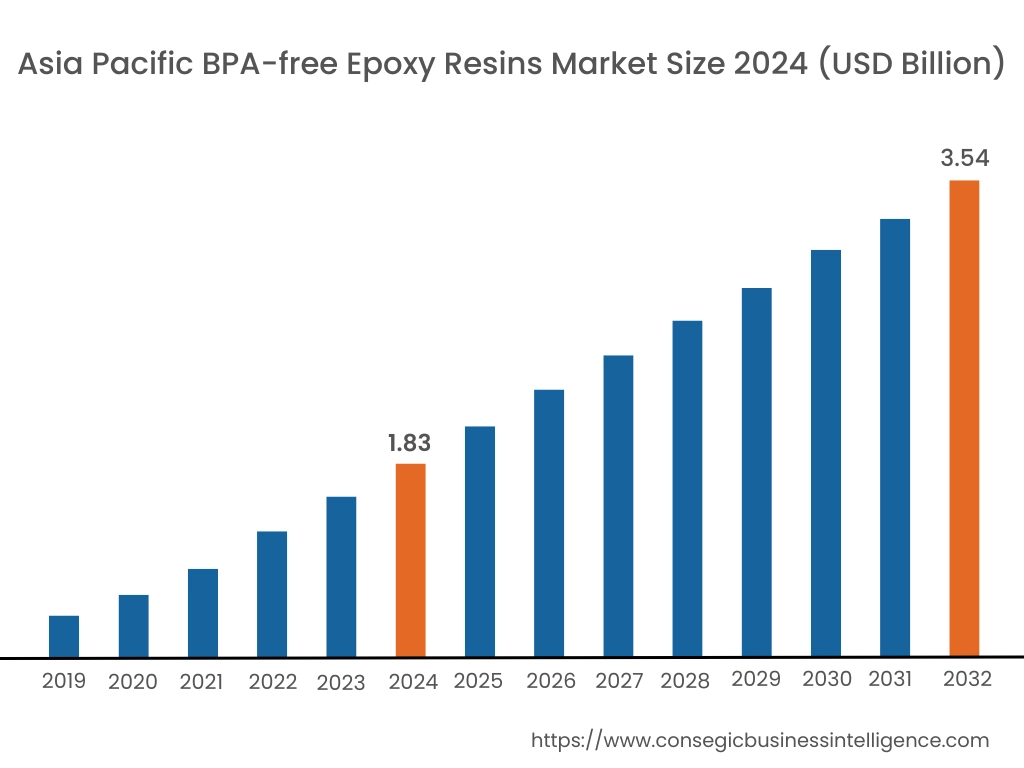
Asia Pacific region was valued at USD 1.83 Billion in 2024. Moreover, it is projected to grow by USD 1.95 Billion in 2025 and reach over USD 3.54 Billion by 2032. Out of this, China accounted for the maximum revenue share of 48.5%. The Asia Pacific region is witnessing rapid increase in the BPA-free epoxy resins industry, primarily due to capacity expansions in countries like China and South Korea. The market in this region is expected to develop at a higher rate, driven by increasing demand from various end-use industries such as electronics, automotive, and construction. Several manufacturers are innovating and developing their product portfolios based on end-user industry requirements, contributing to the rise of the BPA-free epoxy resins market in Asia-Pacific.
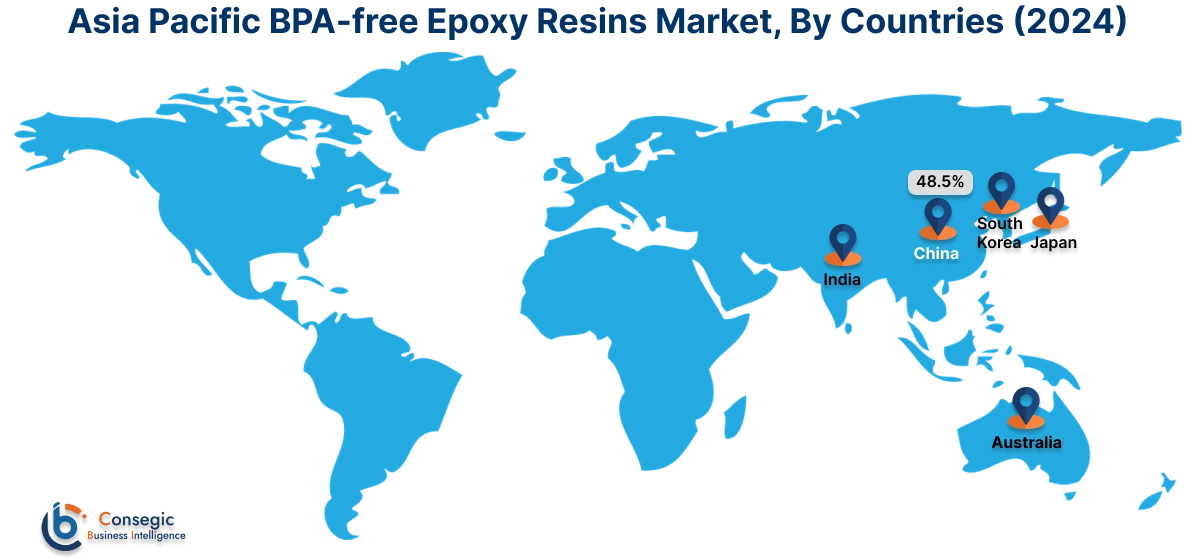
North America is estimated to reach over USD 3.76 Billion by 2032 from a value of USD 2.06 Billion in 2024 and is projected to grow by USD 2.18 Billion in 2025. In North America, the market is expanding due to stringent regulations and growing consumer awareness regarding the health hazards associated with Bisphenol A (BPA). States such as California have implemented strict policies promoting BPA-free products, leading to increased adoption in sectors like food packaging, coatings, and electronics. The region's robust industrial manufacturing base further amplifies the BPA-free epoxy resins market demand, presenting a substantial BPA-free epoxy resins market opportunity for manufacturers focusing on sustainable and non-toxic materials.
Europe holds a significant share of the BPA-free epoxy resins market, with countries like Germany, France, and the United Kingdom leading the demand. The European Union's stringent regulations on the use of BPA, along with the region's strong emphasis on sustainability and green practices, drive the adoption of BPA-free epoxy resins. The market in Europe is expected to grow steadily, supported by the construction, automotive, and electronics industries.
The Latin American market is growing, driven by increasing industrialization and infrastructure development. Countries like Brazil and Mexico are witnessing rising BPA-free epoxy resins market demand in the construction and automotive industries. The overall regional outlook for the BPA-free epoxy resin market is positive, with each region contributing to the market's growth trajectory.
The Middle East and Africa region presents growth opportunities for the BPA-free epoxy resins market, particularly in the construction sector, where the demand for durable and low-maintenance materials is increasing. The overall regional outlook for the BPA-free epoxy resin market is positive, with each region contributing to the market growth.
Top Key Players & Market Share Insights:
The BPA-free epoxy resins market is highly competitive with major players providing products and services to the national and international markets. Key players are adopting several strategies in research and development (R&D), product innovation, and end-user launches to hold a strong position in the global BPA-free epoxy resins market. Key players in the BPA-free epoxy resins industry include -
- Hempel A/S (Denmark)
- Allnex (Germany)
- Olin Corporation (USA)
- Eastman Chemical Company (USA)
- BASF SE (Germany)
- Sun Chemical (USA)
- ISTOYO (USA)
- Westlake Epoxy (USA)
- CREKOAT (China)
Recent Industry Developments :
Acquisitions:
- In February 2021, Westlake Chemical Corporation acquired Hexion Inc.’s global epoxy business. This transaction allowed Westlake to expand its downstream portfolio of coatings and composite products.
BPA-free Epoxy Resins Market Report Insights:
| Report Attributes | Report Details |
| Study Timeline | 2019-2032 |
| Market Size in 2032 | USD 11.61 Billion |
| CAGR (2025-2032) | 8.2% |
| By Product Type |
|
| By Material |
|
| By End-Use Industry |
|
| By Region |
|
| Key Players |
|
| North America | U.S. Canada Mexico |
| Europe | U.K. Germany France Spain Italy Russia Benelux Rest of Europe |
| APAC | China South Korea Japan India Australia ASEAN Rest of Asia-Pacific |
| Middle East and Africa | GCC Turkey South Africa Rest of MEA |
| LATAM | Brazil Argentina Chile Rest of LATAM |
| Report Coverage |
|
Key Questions Answered in the Report
How big is the BPA-free Epoxy Resins Market? +
BPA-free Epoxy Resins Market size is estimated to reach over USD 11.61 Billion by 2032 from a value of USD 6.20 Billion in 2024 and is projected to grow by USD 6.60 Billion in 2025, growing at a CAGR of 8.2% from 2025 to 2032.
What specific segmentation details are covered in the BPA-free Epoxy Resins Market report? +
The BPA-free Epoxy Resins market report includes specific segmentation details for product type, material and end-use industry.
Which is the fastest-growing region in the BPA-free Epoxy Resins Market? +
Asia Pacific is the fastest-growing region in the BPA-free Epoxy Resins market. These trends are encouraged by increasing demand from various end-use industries such as electronics, automotive, and construction.
Who are the major players in the BPA-free Epoxy Resins Market? +
The key participants in the BPA-free Epoxy Resins market are Hempel A/S (Denmark), Allnex (Germany), Sun Chemical (USA), ISTOYO (USA), Westlake Epoxy (USA), CREKOAT (China), Olin Corporation (USA), Eastman Chemical Company (USA) and BASF SE (Germany).
